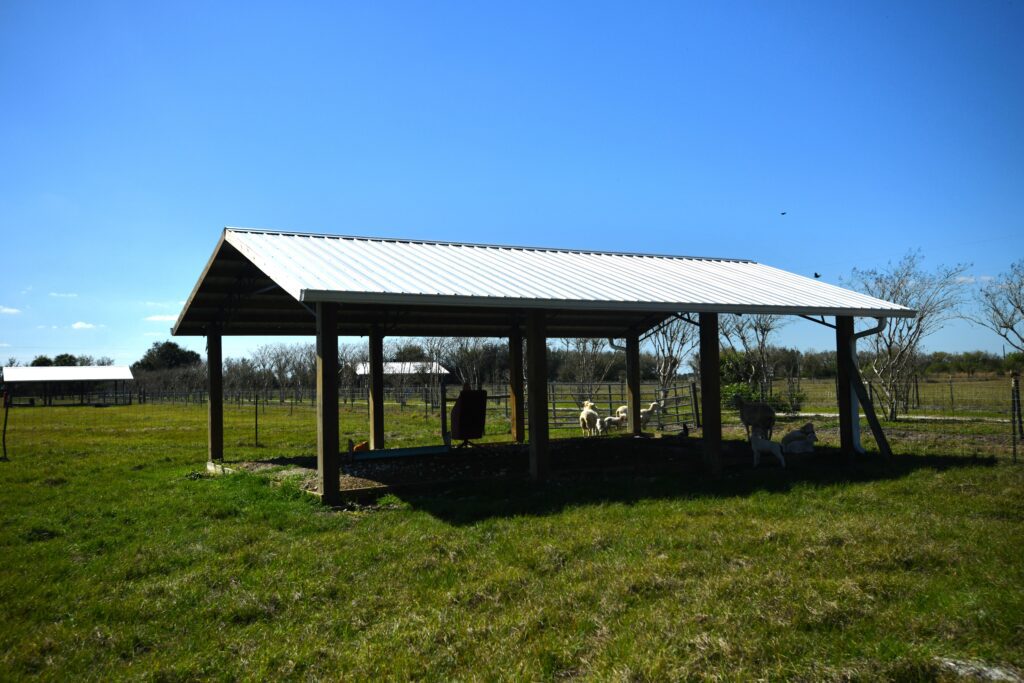article and photos provided by NRCS
Highlands County is known to be home to a predominance of large cattle grazing ranches and citrus groves. Nestled within this rural landscape is Vera Farms — a small 33-acre sheep farm, ornamental plant nursery, and small-scale vegetable production farm owned by Pedro Velez and his wife Maria.
The owners’ dogs doze under an awning at the homestead. A rooster crows in the distance as sheep rest under covered structures and graze on healthy pastures. But it wasn’t always this way. Pedro and Maria didn’t always have time to enjoy a leisurely mid-morning coffee on their farm. Originally from the country of Colombia, Pedro and Maria used to live in Miami and worked with motorcycles and in corporate America, respectively.

“The first two years were really hard, because it was only Pedro,” says Maria. “This was a farm where nobody was taking care of it.” They now have three people on staff helping on the farm.
The fresh air and peaceful scene are exactly why Pedro and Maria chose to move from the bustling city of Miami to a rural farm in Sebring – opting for a better, quieter life for their family, which includes two school-aged children.

As they walked toward their pasture areas, Pedro describes how a pasture management system was put into place with the help of the USDA’s Natural Resources Conservation Service (NRCS) to rotate the sheep between pastures.
“My neighbor told me to speak with Carlos at NRCS, and said he had good programs to help me better manage my farm,” says Pedro. “They helped him with the irrigation of his peach trees, and, through conservation programs, NRCS helped his plant nursery, too.”
On a small scale, Pedro produces liners to supply nursery growers with plants. Several types of ornamental plants are grown in the nursery, and NRCS has aided with a high tunnel system for vegetable growing season. However, Pedro had a greater need to find a better solution to keep his 60+ sheep healthy.
“During the early days of their farm, there was no shade available for the sheep, it was all open space and pasture conditions were poor,” says Carlos Torres-Meléndez, District Conservationist for NRCS. Pedro had planted some trees along the property line, hoping these would provide needed shade for the animals, but these would take about 20 years to mature. The female sheep were aborting their lambs at an alarming rate because of the heat stress.
“One of the components that we added to mitigate the stress and animal mortality was the livestock shelter structures,” says Carlos. “The sheep are sick a lot less, because they now have shaded structures that protect them from the heat of the sun. The animals now have more access to water, and the plants’ conditions have improved.”
“The management for the sheep is easier now because NRCS helped me with the division of the pasture, the watering facility for each pasture, the gates, and the covered areas,” says Pedro.
“By rotating the sheep between pastures, the pastures are now all at the proper height. The grass roots are also stronger,” says Carlos. “They are also saving money not having to feed the sheep hay because they can feed on the pastures.”
“I used to have a lot of problems with the worms. Now I can rotate the sheep every eight or 10 days in each pasture. When you move the sheep, they don’t eat the worm eggs, because those are on the grass that is closer to the ground,” says Pedro.
He can now maintain the forage with optimal growth through the year thanks to the rotational grazing practiced through prescribed grazing. The introduction of legumes has helped add nitrogen to the soil and create forage diversity for the pastures. His NRCS conservation incentive contract also includes treatment of invasive grass to rid the pasture of invasive weeds.
“There is not just one most beneficial conservation practice. It’s all of them together. All the parts have been critical in the successful outcome,” says Maria. “Thanks to NRCS’ help, it is now easier to manage the whole operation.”
The Velez family has participated in NRCS conservation programs since 2020. He applied for EQIP Classic in late 2019 and received funding in 2020. Since then, NRCS has assisted them with prescribed grazing conservation practices including fencing, watering facilities, a well, livestock pipeline, solar pumping plant, and a heavy use area. After being approved for an EQIP Conservation Incentive Contract they are now in their second year of participating in the Conservation Stewardship Program.

What’s next for the farm? Pedro says vegetables, and Maria says flowers! But they both agree on keeping the farm at a manageable size.
“I think one of the things that we agreed on early, when we moved here, was we don’t want to have a large business where we don’t have quality family time.”
The U.S. Department of Agriculture’s Natural Resources Conservation Service in Florida announced on Oct. 23 that it will begin accepting applications for disaster assistance funding through Emergency Environmental Quality Incentives Program.

